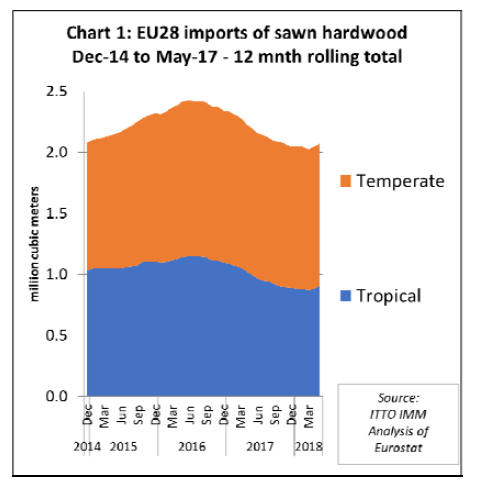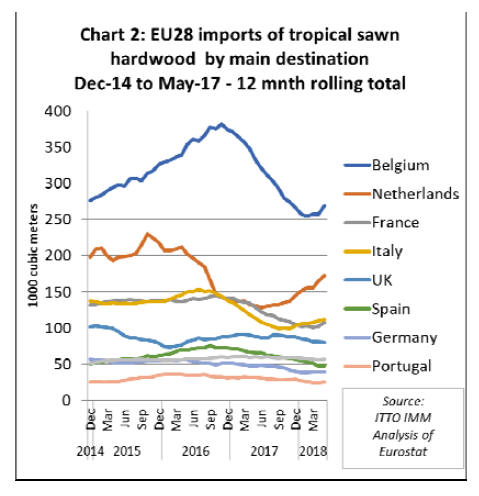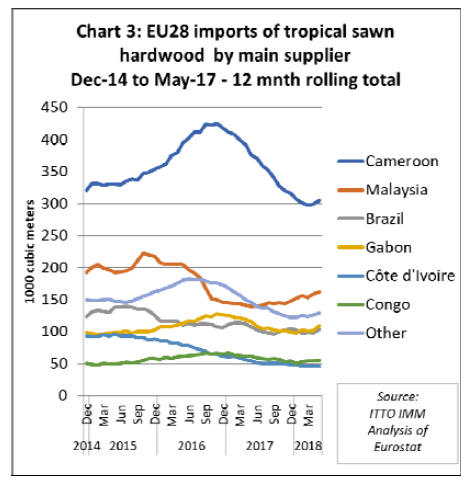|
Report from
Europe
Tropical sawnwood battles for share of buoyant
European market
Recent reports on European economic and construction
sector health and outlook make for almost exclusively
positive reading. After the EU economy enjoyed its
strongest growth in gross domestic product in a decade in
2017, the overviews and forecasts for the first part of 2018
state that not only has expansion continued to date, it is set
to persist through the rest of the year and into 2019.
In the Spring 2018 Forecast from the European
Commission Directorate General of Economics and
Financial Affairs (ECFIN), almost all the EU country
summaries are strongly upbeat. The one exception is the
UK, with its weaker outlook attributed to a large degree to
the political and economic uncertainties surrounding its
prospective departure from the EU.
Euroconstruct also stated at its conference in Helsinki in
June that European construction was set for continued
growth ¡®in the next few years¡¯.
¡°European construction is growing well on the back of low
interest rates, good economic growth and pent-up needs,¡±
the organisation stated. ¡°Economic growth is expected to
remain solid, unemployment will decrease, exports will
grow, interest rates will remain low and the confidence of
consumers and business and industry in the future is high.¡±
It added that increased tax revenues would drive public
building and infrastructure projects, and that immigration
and the ageing of the population would also likely boost
construction.
Against this backdrop, it might be assumed that the
tropical sawn hardwood sector would be among those
benefitting from higher sales. Certainly the rest of the EU
construction products industry is on a strongly upward
curve, even in the UK.
Like much of the rest of the sector in northern Europe,
businesses were was severely disrupted by poor weather in
the first three months of 2018, but the UK Construction
Products Association reports a strong quarter two upturn
in sales and rising confidence in the country¡¯s £56 billion
industry.
EU tropical import figures mixed
However, the latest figures for the tropical sawn hardwood
sector in Europe show a very mixed and fluid picture. In
the first quarter of 2018, European imports were down 6%
compared to the same period in 2017, continuing a long
term trend. However, overall business recovered slightly
over the next two months to leave the January to May
import figure up 4.4% (Chart 1).

The improvement in EU tropical sawn hardwood imports
in the second quarter of 2018 was accounted for mainly by
rising trade in the Netherlands and Belgium. There was
also a slight uptick in imports by Italy and France. Imports
in the other leading tropical timber consuming EU
countries was either flat or declining (Chart 2).

Total EU imports of tropical sawn hardwood for January
to May 2018 were 405,597 cu.m, compared to 388,395
cu.m for the same period the year before. Belgium¡¯s
imports were up 2.1% at 119,354 cu.m, while the
Netherlands¡¯ jumped 45.7% to 88,692 cu.m. France and
Italy¡¯s imports were up respectively 5.5% and 19.7% at
49,517 cu.m and 48,019 cu.m, while Denmark¡¯s rose
23.9% to 8479 cu.m and Poland¡¯s 47.2% to 4,271 cu.m.
Of the larger importers, Spain saw the sharpest
contraction, down 31.8% to 18,129 cu.m, while the UK¡¯s
imports fell 20.1% to 29,903. Germany¡¯s tropical sawn
hardwood trade was down 3.4% to 18,397 cu.m,
Portugal¡¯s 30.3% at 9,623 cu.m, Ireland¡¯s 48.3% at 3,878
cu.m and Greece¡¯s 3.16% at 3,550 cu.m.
There was also divergence in the EU fortunes of various
tropical suppliers. EU imports of sawn hardwood from
Malaysia progressively increased in the first five months
of 2018.
Imports from Cameroon declined in the first three months
of 2018 before recovering a little ground in April and
May. Imports from Gabon, Brazil and Congo remained
static at a relatively low level in the first five months of
2018. Imports from Cote d¡¯Ivoire continued to slide
between January and May this year (Chart 3).

Comparing the January to May period in 2018 with the
same period in 2017, EU imports of sawn hardwood fell
from Cameroon by 8.3% to 124,853, from Brazil by 1.6%
to 48,939 cu.m, from Côte d¡¯Ivoire by 12.8% to 17,593
cu.m, from Suriname by 25.2% to 2,690cu.m and from
Madagascar by 20.6% to 2,915cu.m.
In contrast, in the first five months of 2018 EU sawn
hardwood imports increased from Malaysia by 21.4% to
78,305 cu.m, from Gabon by 23.2% to 53,167 cu.m, from
Congo by 6% to 22,973 cu.m and from Myanmar by
45.5% to 4,932 cu.m.
EU importers face rising competition for supplies
EU timber traders cited a number of factors shaping
tropical import trends. These included intensifying
competition for material from Chinese and other Asian
buyers, which was driving up prices for tropical and
temperate hardwood alike, as well as resulting in short
supply in some species.
But logistical problems, the ¡®deterrent effect¡¯ of the EUTR
in the tropical market on both suppliers and buyers, as one
importer described it, and ever intensifying competition
from rival products, including temperate hardwoods,
modified timber and wood composites, also had an
influence.
The restructuring of the African operations of the Frenchbased
Rougier Group, one of the EU¡¯s key tropical
producers and importers, was also felt to have impacted
the market. And some companies also believe there is an
underlying long term ¡®slow but discernible¡¯ decline in the
EU tropical trade, although this is not a view shared by
everyone.
Interestingly, however, the EU temperate sawn hardwood
market has also been experiencing its own challenges,
notably supply constraints, price inflation and most
recently allegations of illegality and breaches of the EUTR
in one of the best selling species, European oak.
Backlogs grow at Douala Port
One factor in the contraction in Cameroon¡¯s EU exports,
which started in 2016, cited by a number of EU importers,
was the continuing deterioration of operations at the port
of Douala, the key timber trade export hub for much of
Central and West Africa. The government has now
appointed a commission to investigate the ¡®failed
operations¡¯ at the facility. But importers don¡¯t expect rapid
improvement to the rate of throughput and reductions in
backlogs at the port any time soon.
¡°It¡¯s a combination of poor management, old and
unreliable equipment and silting up of access channels,
which means that larger, deep-draft vessels can¡¯t dock,¡±
said an continental EU importer. ¡°Some shippers are
exploring the possibility of using the new, Chinesefunded,
deep-water port at Kribi, but this still has teething
problems, and the only other real alternative is Pointe
Noire in the Republic of Congo.¡±
According to latest reports the backlog of timber for
shipment to China alone at Douala has now reached
60,000cu.m.
As mentioned, the disruption to supply from Rougier¡¯s
Cameroonian operations while the company has been
under protective receivership is also thought to have hit
the country¡¯s overall export figures.
Rougier has now finalised the sale of its businesses SFID,
Cambois and Sud Participation in Cameroon and RSM in
the Central African Republic to Cameroon-based
consortium Sodinaf.
The latter was chosen as the buyer, said Rougier in its July
19 statement, ¡°for the quality of its project, which will
help ensure the sustainability of the activities sold¡±.
At the same time the company said it intended to
¡°continue to be a major player within its industry¡± and
would focus on developing its other more ¡®geographically
aligned¡¯ African operations, notably in Gabon, ¡°in better
conditions¡±.
But, while the situation is now seemingly resolved, some
EU importers feel there may be continuing implications
for trade with the Cameroonian operations.
¡°With those ex-Rougier businesses now in Cameroonian
rather than French ownership, they may well take a
different market view and approach,¡± said an importer,
who also questioned whether the new owners would renew
the FSC-certification which Rougier let lapse under
receivership.
Concentration of EU African import trade
The combination of these factors, with intensifying
competition from Chinese buyers and the administrative
time and cost burden of EUTR compliance is reported by
companies in some EU countries to be leading to further
concentration of the African importing sector.
¡°We¡¯re seeing operators on the periphery of the trade,
previously importing smaller quantities now and again,
coming to us instead,¡± said an importer.
Supply issues are also applying further upward pressure on
African prices. One company said both sapele and
sipo/utile were being quoted €50 to €60 per cu.m more for
quarter one delivery 2019, an increase of around 10% on
current prices. And another importer forecast a further 5-
7% increase in sapele by the year-end.
Iroko and framire/idigbo prices were also reported to have
firmed, with supply of the former improving, but the latter
becoming increasingly difficult to source.
¡°Overall African supply is tight, and drying specialists in
the UK and the Netherlands in particular are finding it
difficult to get enough hardwood to put through their
kilns,¡± said an EU importer.
¡°It¡¯s very much a sellers¡¯ market. Our African suppliers
have full order books and are very bullish. They can pick
and choose their customers and often they¡¯re also
choosing Chinese buyers because they both pay a good
price and don¡¯t require the legality and sustainability
verification we do.¡±
Competitive Asian market
While both Indonesia and Malaysia increased their EU
exports of sawn hardwood in the first five months of 2018,
EU importers reported tight supply due to competition
from Asian buyers and continuing wet weather affecting
harvest and transit.
Lead times for Malaysian keruing and meranti were
extended and prices firming, with the strength of the
ringgit against the dollar said to be adding to price
pressure, while suspension of some suppliers¡¯ certificates
has affected PEFC-certified supply.
Indonesian bangkirai prices are also already up this year,
and importers say more increases are in the pipeline, with
quotes up 20-30% for end-of-year deliveries. One
company also said that the premium on FSC-certified
material over FLEGT-licensed had increased.
Whether FLEGT-licensing is assisting imports from
Indonesia is unclear. One importer said they were
highlighting it in their customer documentation, but others
were doubtful.
¡°It still needs more communication and education in the
market place,¡± said one company. ¡°It¡¯s not sufficiently
understood or valued by our customers, and awareness
decreases the further you go down the supply chain.
Brand recognition is nowhere near the levels for FSC or
PEFC.¡±
EU importers discouraged from importing Myanmar
teak
Given continuing controversy in the EU over whether
Myanmar teak can be traded in compliance with EUTR
requirements, importers questioned by ITTO¡¯s
correspondent were surprised by EU import statistics
showing a 46% increase in sawn hardwood trade with
Myanmar in the first five months of this year. The
statistics indicate that much of the rise in trade was
destined for Italy, Belgium, Germany, and the
Netherlands.
Some NGOs claim that it is not possible, under the
existing regulatory framework in Myanmar, for EU
importers to gather information sufficient to ensure a
negligible risk of teak being from an illegal source in line
with EUTR requirements.
As things stand, this position is effectively endorsed by the
Competent Authorities (CAs) responsible for enforcement
of EUTR at national level in the EU.
At their meeting in November 2017, the European
Commission¡¯s Expert Group on the EUTR and FLEGT
Regulation which provides a forum for member state CAs,
reviewed a statement issued by the Ministry of Natural
Resources and Environmental Conservation (MONREC)
in Myanmar regarding improvements in traceability and
transparency. The Expert Group agreed that this still falls
short of what is needed to demonstrate the origin of the
timber and so ensure full due diligence from an EU
perspective.
A Myanmar delegation recently met with EU officials,
trade bodies, NGOs and CAs, but the outcome was
reported to be ¡®status quo¡¯ with the CA¡¯s assessment of
risk on Myanmar imports unchanged.
Until the matter is resolved, several timber trade bodies,
including Le Commerce du Bois in France and the UK
TTF, are advising members not to import Myanmar teak.
Sharp fall in UK tropical timber imports
UK hardwood companies attributed the particularly sharp
fall in their imports of tropical sawn hardwood to a
number of factors. These included the situation in Douala
and disruption in supply from Rougier, a major supplier to
the country. They reported too that, after heavy buying in
2017, there was an excess of stock on the ground. General
economic uncertainty in the market was additionally
leading to customers buying just in time and little and
often.
Some importers thought too that sales of tropical
hardwood were in long term decline due to a combination
of aversion to perceived illegality risk and increased
consumer acceptance of other products. The UK is a
particularly strong market for modified timber, notably
Accoya, thermo-treated timber and wood composites,
which are reported to be increasing in choice and quality.
One importer recently told the UK¡¯s TTJ magazine that
they saw all these products as ¡°part of the armoury of a
modern timber products and service provider¡±.
Competition from temperate hardwoods was also cited as
a factor in tropical timber sales trends by EU importers,
although as highlighted above, this sector is not without its
own issues.
Prices across the range of temperate species are said to be
firm thanks to demand levels in the EU and competition
from Asian, again notably Chinese buyers, who have been
taking growing quantities of logs as well as sawn timber.
At the European Oak Conference in London in March, the
European Organisation of Sawmill Industries (EOS) stated
that in seven years Europe¡¯s oak lumber exports to China
are up 34%, while log exports have risen 244%. This had
led to demands in France in particular for some form of
controls on log exports.
The recent imposition of phytosanitary restrictions on US
hardwood logs by China was expected by some to
alleviate demand pressure in the market. However, one
importer thought that it might lead to Chinese buyers
sourcing more US hardwood lumber instead.
European oak export controls
Adding price inflationary and demand pressure in the
European oak market are export and transit controls on
oak logs and green lumber in Croatia, ostensibly to curb
the spread of oak lace beetle (Corythucha arcuata).
At the European Oak Conference a representative of the
Croatian Oak Cluster said the controls might be relaxed
this summer, but according to the EOS there is no news to
date.
The latest is that Croatian authorities have informed the
European Commission Standing Committee on Plant,
Animals, Food and Feed (PAFF) that their course of action
would be decided in July following consideration of a new
report into the effectiveness of measures to control spread
of the beetle.
The ten-year ban on unprocessed timber exports from
Ukraine has also impacted on EU oak processors and has
been challenged by the EU authorities.
Now, following an investigation by ENGO Earthsight,
there is also added concern that lumber from Ukrainian
mills entering EU supply chains may have derived from
illegally felled trees, including oak.
Earthsight alleges that Ukrainian rules allowing felling of
diseased trees have been illicitly used to harvest healthy
forest. The subsequent timber, some of it stamped FSCcertified,
was then finding its way, despite EUTR due
diligence, into neighbouring EU countries, notably Poland
and Romania. The NGO said corruption in Ukrainian
authorities was facilitating the trade.
On July 18 Ukrainian prime minister Volodymyr
Groysman, seemingly in response to the Earthsight
expos¨¦, said he was initiating a crackdown on illegal
timber and appealed to the EU to provide information on
imports of timber from his country. But in the meantime
an importer said his company was ¡°interrogating all
European oak imports much more closely¡±.
Turning back to tropical timber, the International Tropical
Timber Technical Association (ATIBT) says that its Fair
& Precious brand-based marketing initiative to promote
tropical timber internationally was continuing to roll out.
Speaking at the EU FLEGT Independent Market Monitor
Trade Consultation in Nantes in June, the organisation said
the Fair&Precious brand was open to companies across the
tropical timber supply chain which committed to source
material legally and sustainably, and to submit to third
party audit of their procurement practice.
ATIBT also said it would be considering where the
FLEGT VPA initiative and FLEGT licensed timber might
fit in the Fair&Precious sourcing criteria.
Meanwhile the 2018 conference of the Sustainable
Tropical Timber Coalition, the industry alliance dedicated
to increasing sustainably sourced tropical timber sales in
Europe, has the theme of using data and market
intelligence to drive market share. It takes place in Paris
on October 25 (www.europeansttc.com).
|